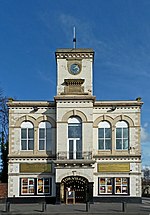Knottingley TMD
KnottingleyRail transport in West YorkshireRailway depots in YorkshireUse British English from December 2016

Knottingley TMD was a traction maintenance depot located in Knottingley, West Yorkshire, England. The depot was situated on the Pontefract Line and was near Knottingley station. It opened in 1967 to maintain the locomotives and hopper wagons for a planned 75 Merry-go-round trains a day, expected to use the Wakefield and Goole line.
Excerpt from the Wikipedia article Knottingley TMD (License: CC BY-SA 3.0, Authors, Images).Knottingley TMD
Cleveland Avenue, Wakefield
Geographical coordinates (GPS) Address Nearby Places Show on map
Geographical coordinates (GPS)
| Latitude | Longitude |
|---|---|
| N 53.7061 ° | E -1.2539 ° |
Address
Cleveland Avenue
Cleveland Avenue
WF11 8EN Wakefield
England, United Kingdom
Open on Google Maps








